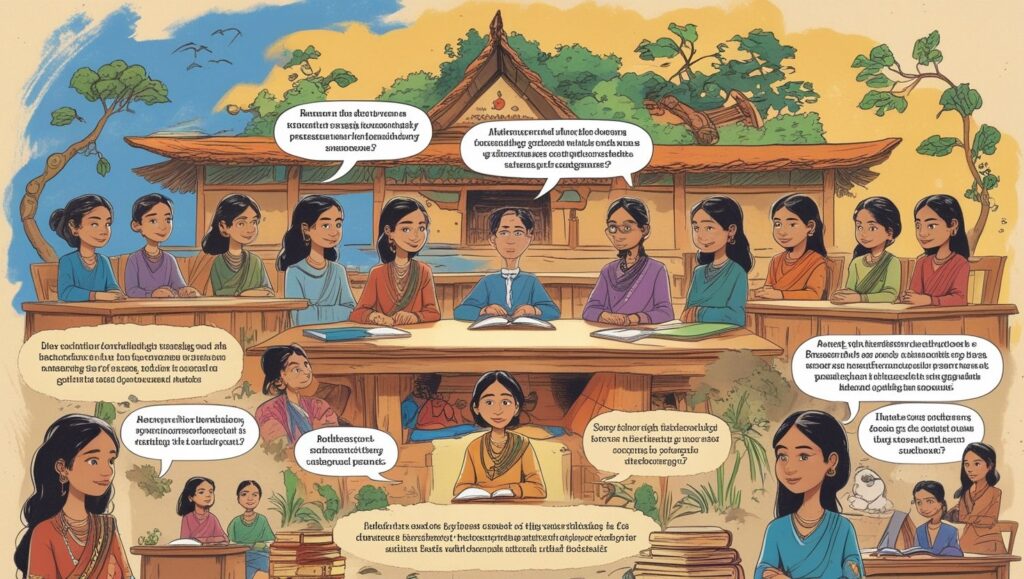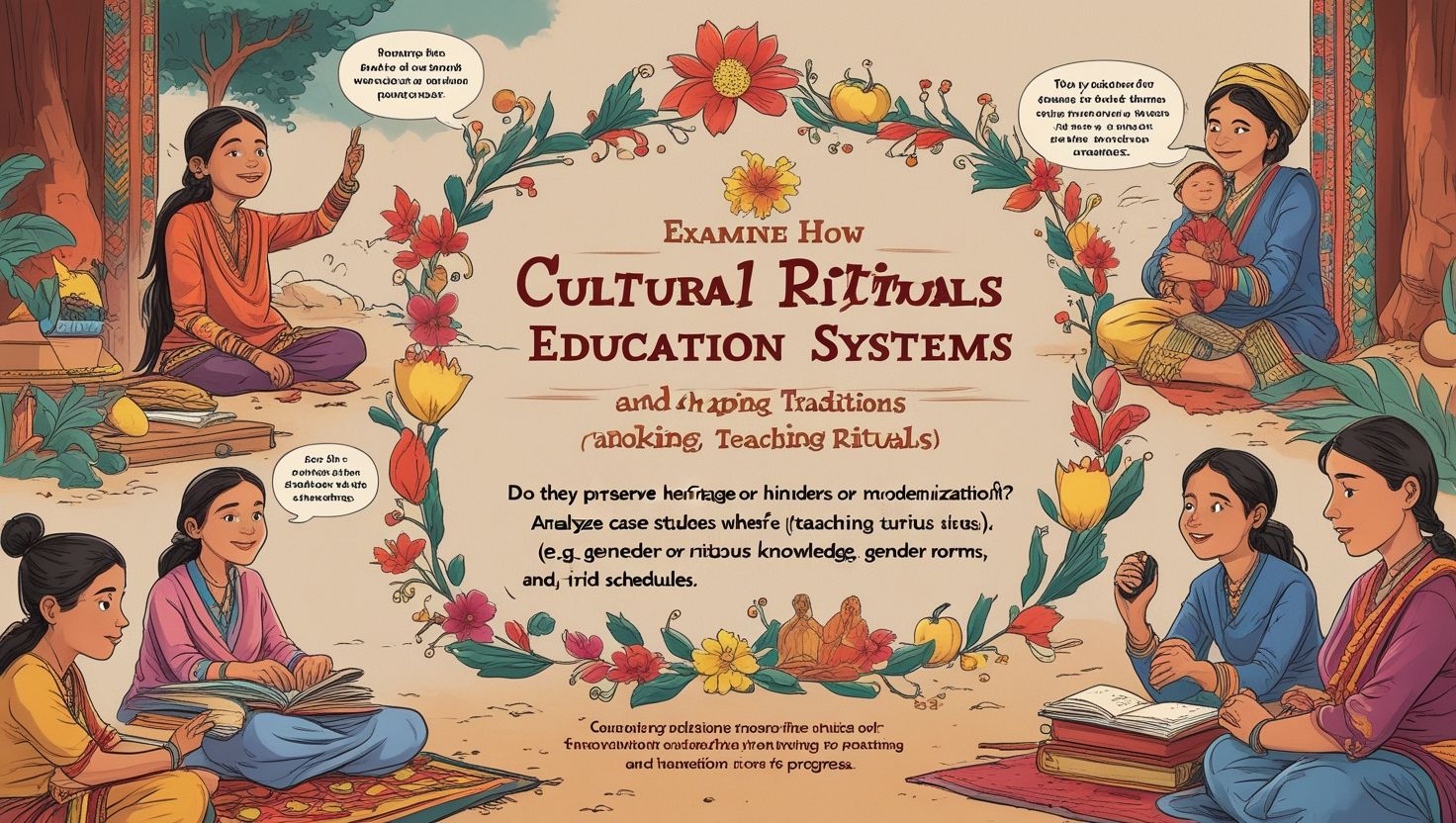1. Introduction:
Impact of Culture and Rituals on Education, Culture and rituals are foundational elements that shape educational experiences across societies. Culture encompasses the beliefs, values, customs, and social behaviors of a group, while rituals are the ceremonial acts that express these cultural values. In educational settings, these elements influence teaching methods, curriculum content, classroom interactions, and students’ learning processes. Recognizing and integrating cultural and ritualistic practices into education can enhance student engagement, foster inclusivity, and promote a deeper understanding of diverse perspectives.
Conversely, neglecting these aspects may lead to cultural dissonance and hinder the educational development of students from diverse backgrounds. As globalization continues to bring diverse cultures into closer contact, it becomes increasingly important for educational systems to adapt and respond to this diversity. By examining the impact of culture and rituals on education, educators and policymakers can develop strategies that respect cultural identities while promoting equitable learning opportunities for all students.
2. Cultural Influences on Educational Philosophies
Educational philosophies are deeply rooted in cultural contexts, shaping how societies perceive knowledge, learning, and the purpose of education. For instance, Confucianism, prevalent in East Asian cultures, emphasizes respect for authority, collective harmony, and moral development, leading to educational systems that prioritize discipline, rote memorization, and teacher-centered instruction. In contrast, Western educational philosophies, influenced by Enlightenment ideals, often promote individualism, critical thinking, and student-centered learning approaches.
These cultural underpinnings affect curriculum design, assessment methods, and classroom dynamics. Understanding these cultural influences is crucial for educators working in multicultural environments, as it enables them to bridge cultural gaps and create inclusive learning experiences. Moreover, acknowledging diverse educational philosophies can foster mutual respect and collaboration among students from different cultural backgrounds, enriching the educational experience and preparing students for global citizenship.classcoupon.com

3. Rituals and Their Role in Educational Settings
Rituals in educational settings serve to reinforce cultural values, create a sense of community, and mark significant milestones in students’ academic journeys. These rituals can range from daily routines, such as morning assemblies and classroom greetings, to annual events like graduation ceremonies and cultural festivals. They provide structure and predictability, which can enhance students’ sense of security and belonging. Incorporating culturally relevant rituals into the school environment acknowledges and respects students’ backgrounds, fostering inclusivity and engagement.
For example, celebrating cultural holidays or incorporating traditional practices into classroom activities can validate students’ identities and promote cross-cultural understanding among peers. However, it’s essential for educators to approach rituals with sensitivity and inclusivity, ensuring that all students feel respected and included. By thoughtfully integrating rituals into educational settings, schools can create a supportive environment that honors diversity and enhances the overall learning experience.
4. Indigenous Knowledge and Educational Practices
Indigenous knowledge systems offer valuable perspectives and methodologies that can enrich educational practices. These systems are often characterized by holistic approaches to learning, emphasizing the interconnectedness of people, nature, and spirituality. Incorporating indigenous knowledge into education can promote cultural preservation, environmental stewardship, and community engagement. For instance, the Schools of Living Traditions in the Philippines focus on teaching indigenous arts, crafts, and traditions through community-managed centers, preserving cultural heritage and providing practical skills to students.
Similarly, integrating indigenous storytelling, languages, and ecological knowledge into curricula can enhance students’ understanding of diverse worldviews and foster respect for cultural diversity. However, it’s crucial to approach the inclusion of indigenous knowledge with cultural sensitivity and collaboration with indigenous communities to ensure authenticity and respect. By valuing and integrating indigenous educational practices, schools can offer more inclusive and culturally responsive education that benefits all learners.digitallearningedge.com+1geekmode.blog+1en.wikipedia.org
5. Religious Practices and Educational Environments
Religious practices significantly influence educational environments, shaping values, behaviors, and institutional policies. In many cultures, education is intertwined with religious teachings, with schools serving as centers for both academic and spiritual learning. Religious rituals, such as prayers, fasting, and observance of holy days, can impact students’ daily routines and participation in school activities. For example, students observing Ramadan may experience changes in energy levels and concentration, affecting their academic performance.
Schools accommodating such practices by adjusting schedules or providing spaces for prayer demonstrate respect for students’ religious commitments. However, balancing religious accommodations with secular educational mandates can be challenging, particularly in diverse or secular societies. Ensuring that educational environments are inclusive and respectful of various religious practices requires thoughtful policies and open communication among educators, students, and families. By acknowledging and accommodating religious practices, schools can create supportive environments that respect students’ identities and promote equitable learning opportunities.
6. Language, Culture, and Learning
Language is a fundamental aspect of culture and plays a critical role in the learning process. Students’ linguistic backgrounds influence how they interpret information, engage with content, and express their understanding. In multilingual classrooms, incorporating students’ native languages can enhance comprehension and participation, fostering a more inclusive learning environment.
Bilingual education programs, for instance, support language development while respecting cultural identities. Moreover, language preservation efforts, such as integrating indigenous languages into curricula, contribute to cultural continuity and diversity. However, language barriers can pose challenges, potentially leading to misunderstandings and reduced academic performance. Educators must employ culturally responsive teaching strategies, including visual aids, collaborative learning, and differentiated instruction, to support language development and content mastery. By recognizing the interplay between language and culture, educators can create learning environments that honor students’ linguistic identities and promote academic success.digitallearningedge.com
7. Cultural Celebrations and School Activities
Integrating cultural celebrations into school activities enriches the educational experience by promoting diversity, inclusivity, and cross-cultural understanding. Events such as cultural festivals, heritage months, and international days allow students to share their traditions, foods, music, and customs, fostering a sense of pride and belonging. These celebrations provide opportunities for experiential learning, where students engage with different cultures in meaningful ways. For example, organizing a multicultural fair can encourage students to research and present aspects of various cultures, enhancing their research skills and cultural awareness.
Moreover, such activities can break down stereotypes and build empathy among students from diverse backgrounds. However, it’s essential to approach cultural celebrations with authenticity and respect, avoiding tokenism or cultural appropriation. Collaborating with community members and cultural representatives can ensure accurate and respectful representations. By thoughtfully incorporating cultural celebrations into school activities, educators can create inclusive environments that value and celebrate diversity.

8. Cultural Norms and Classroom Behavior
Cultural norms significantly influence classroom behavior, affecting students’ interactions, communication styles, and perceptions of authority. For instance, in some cultures, students may be taught to show respect by remaining silent and not questioning teachers, which could be misinterpreted as disengagement in educational systems that encourage active participation. Understanding these cultural differences is crucial for educators to create inclusive and effective learning environments. Implementing culturally responsive classroom management strategies involves recognizing and valifying diverse behavioral norms, setting clear expectations, and fostering open communication.
Educators can also incorporate culturally relevant examples and teaching methods to bridge cultural gaps and enhance student engagement. Professional development and cultural competency training can equip teachers with the skills to navigate cultural dynamics and address potential misunderstandings. By acknowledging and respecting cultural norms, educators can foster positive classroom environments that support all students’ learning and development.
9. Challenges and Opportunities in Multicultural Education
Multicultural education presents both challenges and opportunities in creating inclusive and equitable learning environments. Challenges include addressing language barriers, combating stereotypes and biases, and ensuring representation in curriculum content. Educators may also face difficulties in balancing diverse cultural perspectives while maintaining academic standards. However, multicultural education offers significant opportunities for enriching students’ learning experiences.
It promotes critical thinking, empathy, and global awareness by exposing students to diverse viewpoints and fostering respect for differences. Implementing multicultural education involves integrating diverse cultural content into curricula, employing inclusive teaching strategies, and encouraging student collaboration across cultural lines. Engaging families and communities in the educational process can also enhance cultural understanding and support student success. By embracing the complexities of multicultural education, schools can prepare students to thrive in diverse societies and contribute positively to a globalized world.
10. Conclusion:
Embracing cultural diversity in education is essential for fostering inclusive, respectful, and effective learning environments. Culture and rituals profoundly influence educational experiences, shaping students’ identities, values, and learning processes. By integrating cultural perspectives into curricula, acknowledging diverse rituals, and adapting teaching methods to accommodate various cultural norms, educators can enhance student engagement and academic achievement.
Moreover, culturally responsive education promotes social cohesion, reduces prejudice, and prepares students to navigate and contribute to an increasingly interconnected world. Achieving this requires commitment from educators, administrators, policymakers, and communities to prioritize cultural competency, inclusivity, and equity in education. Through continuous reflection, collaboration, and adaptation, educational systems can honor the rich tapestry of human cultures and empower all

qqz8ik
It’s perfect time to make some plans for the future and it’s time to be happy. I have read this post and if I could I wish to suggest you few interesting things or tips. Perhaps you can write next articles referring to this article. I wish to read more things about it!
me encantei com este site. Pra saber mais detalhes acesse nosso site e descubra mais. Todas as informações contidas são conteúdos relevantes e únicos. Tudo que você precisa saber está ta lá.
I discovered your blog website on google and examine a few of your early posts. Continue to maintain up the very good operate. I just extra up your RSS feed to my MSN News Reader. Searching for ahead to reading more from you later on!…
fantástico este conteúdo. Gostei bastante. Aproveitem e vejam este conteúdo. informações, novidades e muito mais. Não deixem de acessar para descobrir mais. Obrigado a todos e até a próxima. 🙂
Would you be fascinated with exchanging hyperlinks?
Hello! I just would like to give a huge thumbs up for the great info you have here on this post. I will be coming back to your blog for more soon.
A person essentially help to make seriously articles I would state. This is the very first time I frequented your web page and thus far? I amazed with the research you made to create this particular publish extraordinary. Wonderful job!
You have brought up a very fantastic points, regards for the post.
Thanks , I’ve just been searching for information about this topic for ages and yours is the best I’ve discovered till now. But, what about the conclusion? Are you sure about the source?
Whats Taking place i am new to this, I stumbled upon this I’ve discovered It absolutely helpful and it has helped me out loads. I’m hoping to contribute & assist different customers like its aided me. Great job.
I consider something really special in this web site.
You are my aspiration, I own few web logs and rarely run out from to brand : (.